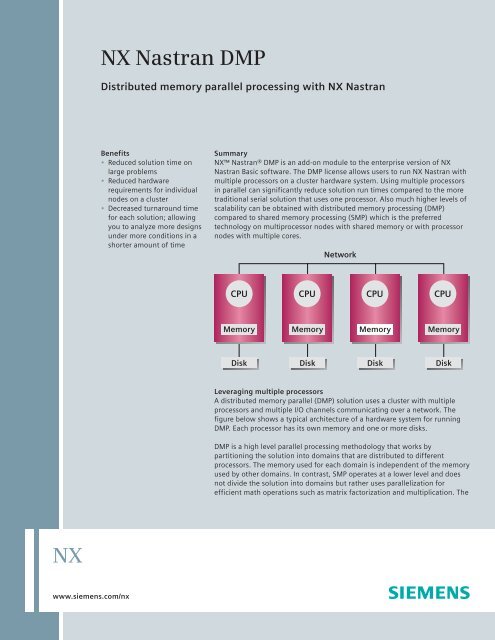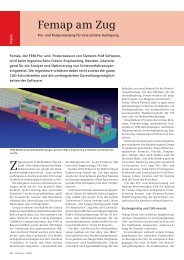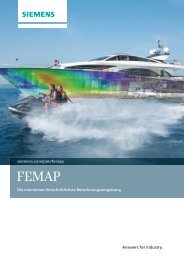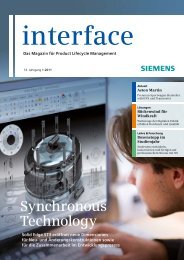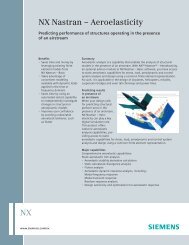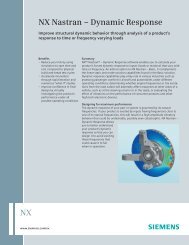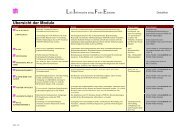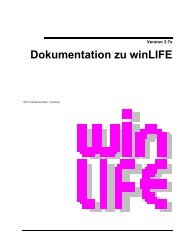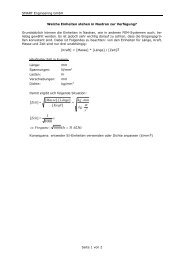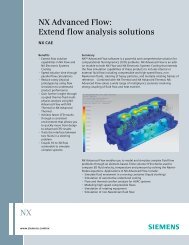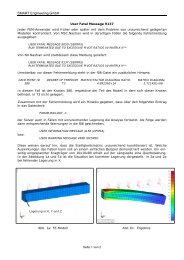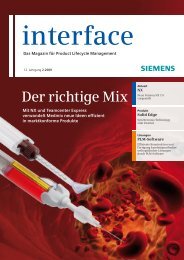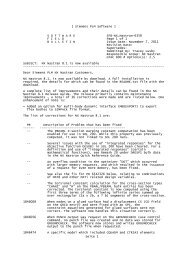NX Nastran DMP - Siemens PLM Software
NX Nastran DMP - Siemens PLM Software
NX Nastran DMP - Siemens PLM Software
You also want an ePaper? Increase the reach of your titles
YUMPU automatically turns print PDFs into web optimized ePapers that Google loves.
<strong>NX</strong> <strong>Nastran</strong> <strong>DMP</strong><br />
Distributed memory parallel processing with <strong>NX</strong> <strong>Nastran</strong><br />
Benefits<br />
• Reduced solution time on<br />
large problems<br />
• Reduced hardware<br />
requirements for individual<br />
nodes on a cluster<br />
• Decreased turnaround time<br />
for each solution; allowing<br />
you to analyze more designs<br />
under more conditions in a<br />
shorter amount of time<br />
Summary<br />
<strong>NX</strong> <strong>Nastran</strong>® <strong>DMP</strong> is an add-on module to the enterprise version of <strong>NX</strong><br />
<strong>Nastran</strong> Basic software. The <strong>DMP</strong> license allows users to run <strong>NX</strong> <strong>Nastran</strong> with<br />
multiple processors on a cluster hardware system. Using multiple processors<br />
in parallel can significantly reduce solution run times compared to the more<br />
traditional serial solution that uses one processor. Also much higher levels of<br />
scalability can be obtained with distributed memory processing (<strong>DMP</strong>)<br />
compared to shared memory processing (SMP) which is the preferred<br />
technology on multiprocessor nodes with shared memory or with processor<br />
nodes with multiple cores.<br />
Network<br />
CPU<br />
CPU<br />
CPU<br />
CPU<br />
Memory<br />
Memory<br />
Memory<br />
Memory<br />
Disk<br />
Disk<br />
Disk<br />
Disk<br />
Leveraging multiple processors<br />
A distributed memory parallel (<strong>DMP</strong>) solution uses a cluster with multiple<br />
processors and multiple I/O channels communicating over a network. The<br />
figure below shows a typical architecture of a hardware system for running<br />
<strong>DMP</strong>. Each processor has its own memory and one or more disks.<br />
<strong>DMP</strong> is a high level parallel processing methodology that works by<br />
partitioning the solution into domains that are distributed to different<br />
processors. The memory used for each domain is independent of the memory<br />
used by other domains. In contrast, SMP operates at a lower level and does<br />
not divide the solution into domains but rather uses parallelization for<br />
efficient math operations such as matrix factorization and multiplication. The<br />
<strong>NX</strong><br />
www.siemens.com/nx
<strong>NX</strong><br />
<strong>NX</strong> <strong>Nastran</strong> <strong>DMP</strong><br />
processors work independently but the<br />
memory is shared. The independence of<br />
the memory usage by processors in a <strong>DMP</strong><br />
solution allows for much greater leveraging<br />
of parallelization thus providing a<br />
higher level of scalability. With <strong>NX</strong> <strong>Nastran</strong><br />
<strong>DMP</strong>, scalability levels to 64 processors<br />
have been obtained with no loss of<br />
performance.<br />
<strong>DMP</strong> Implementations<br />
<strong>DMP</strong> solutions involve a physical subdivision<br />
of the model solution domain<br />
into partitions that are distributed and<br />
processed separately. The user only needs<br />
to specify the number of processors,<br />
and the partitioning of the solution is<br />
done internally.<br />
<strong>NX</strong> <strong>Nastran</strong> has the following options for<br />
partitioning of the solution domain.<br />
• Geometric domain<br />
• Frequency domain<br />
• Hierarchic domain<br />
• Load domain<br />
• Recursive substructuring domain<br />
Geometric domain partitioning is available<br />
for static and dynamic solutions. The<br />
physical model is divided into geometry<br />
partitions that are solved on different<br />
processors. This table, in which N is the<br />
total number of physical DOFs and p is the<br />
number of processors, demonstrates the<br />
potential advantages for such<br />
decomposition.<br />
Not partitioned<br />
Frequency domain partitioning is available<br />
for dynamic solutions. The solution is<br />
partitioned into frequency range segments<br />
that are solved separately with no communication<br />
needed between the smaller<br />
solutions. For example, in an eigenvalue<br />
analysis for computing modes to 200 Hz,<br />
two domains can be used – one from<br />
0-120 Hz, another from 120-200 Hz. The<br />
actual frequency boundaries are automatically<br />
computed by <strong>NX</strong> <strong>Nastran</strong> based<br />
on a modal density estimate – the goal to<br />
evenly balance the number of modes<br />
solved on each processor.<br />
Hierarchic domain partitioning is a hybrid<br />
of geometry and frequency domain<br />
methods. It is used for modal solutions and<br />
allows for partitioning of geometry and<br />
the modal frequency domains at the same<br />
Partitioned<br />
Problem size N n=N/p<br />
Operation cost N 3 =p 3 n 3 pn 3<br />
Remarks p 3 >p<br />
time. Using the two methods together<br />
allows scalability to higher levels than<br />
could be obtained with either method<br />
individually. The figure shows the<br />
scalability obtained by an hierarchic<br />
partition of a car body model out to<br />
64 processors.<br />
Load domain partitioning is available for<br />
use in static analyses and is useful when<br />
there are many load cases (> 100) to solve.<br />
For such solutions the forward-backward<br />
substitution (FBS), needed for each load<br />
set, can take more time to solve than the<br />
one time numerically intensive stiffness<br />
matrix decomposition. Partitioning the<br />
load domain leverages parallelization for<br />
the FBS by distributing load sets to<br />
multiple processors. Like frequency<br />
domain partitioning, load domain<br />
Not included in the table is the effect of<br />
the connections between the geometry<br />
partitions. These connections require<br />
communication through the message<br />
passing interface (MPI) between the<br />
processors. Therefore the geometry should<br />
be partitioned such that there is minimal<br />
connectivity between the partitions to<br />
minimize the communication overhead.<br />
For this reason, <strong>NX</strong> <strong>Nastran</strong> <strong>DMP</strong> has<br />
several automated partitioning algorithms<br />
for determining an optimal set of<br />
geometric domains. In general, partitioning<br />
works better on shell dominant<br />
models where small domain boundaries<br />
can be found compared to “chunky” solid<br />
models that result in a large number of<br />
DOFs at the domain boundaries.<br />
Solution speed up<br />
25<br />
20<br />
15<br />
10<br />
15<br />
0<br />
1 4 8 16 24 32 48 56 64<br />
Number of CPUs
<strong>NX</strong><br />
partitioning does not need communication<br />
between processors and is nearly linearly<br />
scalable.<br />
1200<br />
100.0<br />
Recursive substructuring is the newest<br />
<strong>DMP</strong> method. It works for modal solutions<br />
and is the most scalable solution yet. It<br />
operates on multilevel partitions of the<br />
mass and stiffness matrices by performing<br />
automated matrix reduction. As a mathematical<br />
reduction method, the resulting<br />
solution is approximate compared to the<br />
other <strong>DMP</strong> methods. However, experience<br />
has shown that the approximation is very<br />
good and has very little difference with an<br />
exact solution.<br />
Speed up<br />
80.8<br />
60.0<br />
40.0<br />
20.0<br />
0.0<br />
1<br />
(Lancos)<br />
1<br />
(Recurs )<br />
2 4 8 16 32 64 128<br />
Number of CPUs<br />
Good scalability of this method has been<br />
achieved out to 128 CPUs for a car body<br />
model as shown by the figure. Using the<br />
Lanczos method on a single processor as<br />
the baseline, the recursive <strong>DMP</strong> solution<br />
can solve more than 100 times faster. It is<br />
noted that the recursive method can also<br />
be run on a single processor and because<br />
substructuring leverage runs 4 times faster<br />
than Lanczos.<br />
Solutions and domain options<br />
The table lists the <strong>NX</strong> <strong>Nastran</strong> solutions<br />
that are have enabled <strong>DMP</strong> processing and<br />
the domain decompositions are available<br />
for each.<br />
<strong>DMP</strong> Implementations in solution sequences<br />
Solution Geometric Frequency Recursive Hierarchic Load<br />
101 • •<br />
103 • • • •<br />
108 •<br />
111 • • • •<br />
112 • • • •<br />
200 • • • •<br />
Availability<br />
<strong>NX</strong> <strong>Nastran</strong> <strong>DMP</strong> is contained in the<br />
<strong>NX</strong> <strong>Nastran</strong> Advanced bundle or can be<br />
purchased as an add-on with any of the<br />
<strong>Nastran</strong> solution types outlined in the<br />
chart above. <strong>NX</strong> <strong>Nastran</strong> <strong>DMP</strong> is not<br />
available with the desktop versions of<br />
<strong>NX</strong> <strong>Nastran</strong>.<br />
Contact<br />
<strong>Siemens</strong> Industry <strong>Software</strong><br />
Americas +1 800 498 5351<br />
Europe +44 (0) 1276 702000<br />
Asia-Pacific +852 2230 3333<br />
www.siemens.com/plm<br />
© 2011 <strong>Siemens</strong> Product Lifecycle Management <strong>Software</strong> Inc.<br />
All rights reserved. <strong>Siemens</strong> and the <strong>Siemens</strong> logo are registered<br />
trademarks of <strong>Siemens</strong> AG. D-Cubed, Femap, Geolus, GO <strong>PLM</strong>,<br />
I-deas, Insight, JT, <strong>NX</strong>, Parasolid, Solid Edge, Teamcenter,<br />
Tecnomatix and Velocity Series are trademarks or registered<br />
trademarks of <strong>Siemens</strong> Product Lifecycle Management <strong>Software</strong><br />
Inc. or its subsidiaries in the United States and in other<br />
countries. <strong>Nastran</strong> is a registered trademark of the National<br />
Aeronautics and Space Administration. All other logos,<br />
trademarks, registered trademarks or service marks used herein<br />
are the property of their respective holders.<br />
X4 12563 10/11 C


